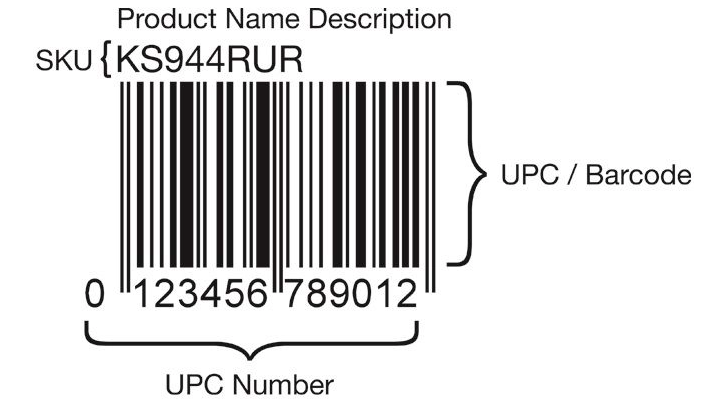What is SKU?
A stock keeping unit, or SKU as it’s commonly abbreviated, is a product and identification code that is assigned to a particular product or store. They’re typically shown as a barcode that’s readable by machines which work to track the item for that particular store’s inventory purposes. Also, SKU’s aren’t solely assigned to physical products in the inventory, they’re also used for intangible services like warranties, repairs, house cleaning, tutors, etc.
How do they work?
In short, whenever you’re analyzing your inventory in your POS or accounting system, a particular product’s SKU gives you the opportunity to track unique information in regards to the product. SKU’s are also very particular, in that each retailer has their own set of SKUs for all of their merchandise.
To give you a better idea of why SKU numbers are so valuable to retail store owners, take a look at some of the benefits below.

- Improved customer experience
A drawn-out SKU system can make any tasks related to customer service or check out move much quicker, as well as with much fewer errors. For instance, when you use a POS system to track products using their SKU numbers, the numbers work to ensure the accuracy of all of your inventory as well as assuring that your pricing is correct. So during the customers’ check out process, their purchases will automatically ring up with the correct pricing for that particular product. Along with that, the quantity-on-hand amount that you have for that particular product would be automatically reduced by the amount that the customer purchased.
To expedite the check-out process even further, you can also utilize scannable barcode labels on all of your products that will enable your cashiers to check products out even faster. Another way that SKUs can help your customer experience is by giving store employees the ability to quickly look up an item for a customer to see if you all have it in your inventory. This is accomplished by inputting the SKU number into the store’s POS system, which will display if whether or not the item is in stock. Your staff is then able to locate the product for the customer, thus giving you an extra sale along with improving your store’s reputation by providing excellent customer service. As you can see, SKU numbers provide plenty of real-world advantages for improving your overall level of customer experience.
Another real-world advantage for improving your customer experience is by assuring you always have enough employees on staff to help customers with any issues or questions that they may have. The best way of achieving this is by using an employee scheduling platform like Deputy, which allows you to easily build and send out your employee schedules. To learn more, click on the button below to begin your trial.

- Improved shopping experience
An unexpected advantage of SKUs is that they optimize your store’s layout so your customers, as well as your staff, are able to quickly & easily find any items they may be searching for. This is because SKUs work to categorize the items in your store in many different ways. You can track items by:
- Type of item
- Department
- Collection type
- Seller or vendor
- Price

This works to give your store a more organized feel as well as providing your customers with an inviting, easy shopping experience that will keep them coming back which equals to more profits made for your organization.
Another area that is crucial for providing a great shopping experience for customers is having enough employees scheduled at all times so your customers are able to find help whenever they need to.
- Better inventory management

Are you aware of what shrinkage is in the world of retail? In short, it’s the loss of a store’s inventory that can be attributed to shoplifting, employee theft, vendor fraud, damage that occurred during transportation, cashier errors, and inventory management errors. Retail shrinkage is no small issue either, in fact, retailers lose an average of $60 billion each year due to shrinkage. While employee theft accounts for the majority of the money lost from retail shrinkage, inventory management errors made during the intake of new shipment is also an area where a substantial amount of money is lost for retailers. These errors are much worse than a typical employee error because they cause a domino effect that will cause much larger issues down the line that can really hurt your organization.
This is where SKUs can really help your retail store. They provide a manageable way for you to track all of your inventory down to the last item, as well as being able to quickly recount the number of items you have in stock.
Here’s an example that can better demonstrate what I’m talking about: Say you’re running a health supplement store and aren’t using any SKUs to organize the items in your stockroom. You go to restock a particular brand of protein powder that your store has just run out of on the floor, only to find that you’re unable to find the protein powder in its typical spot in the stockroom. So you immediately go to order an extra shipment of the item. After you get done and head back to the store floor, you notice that one of your employees is re-stocking the empty shelf with the protein powder that you thought was out of stock. After speaking with them, you both head back to find that you did have an extra batch of the protein powder in stock. It’s just that an employee placed it in the wrong section, so you assumed that you ran out of stock of the item when you really had enough to last you until the next shipment. So you hurry off to see if you’re still able to cancel the extra order that you made.
The example above displays exactly how SKUs work to strengthen your inventory management procedures and assures that you don’t end up spending extra money on inventory you didn’t even need in the first place. If the manager in the above example had SKUs for all of their merchandise, then they could have simply looked up the item rather then looking in their stockroom and seeing in their systems that they indeed had the particular brand of protein powder in stock in the back.
Not only that but if your store also has an e-commerce platform to accompany the physical store, SKUs will allow your visiting customers to see if you have particular items in stock. Completely eliminating the need for them to call your store or to come in and check in person.
- Makes selling to other stores much easier

Although you may solely be focusing on selling to the individual customers that walk into your store, you never know where the future can take your organization. It is possible that you scale your operations by so much, that you end up selling wholesale to other stores. While this would be a great way to grow your brand as well as make more money, the stores that you sell to will definitely expect you to have SKU number to accompany the products you sell to them. That’s because these stores that you’re selling wholesale to will expect your items to come with SKU numbers so they’re able to set the different kinds of items apart. This is especially important if the store sells multiple sets of similar items like red shirts, queen sized bed sets, different brands of the same color of paint, etc.
SKU vs UPC
Now that you’re better aware of how SKUs work to benefit your business, it’s about time you get introduced to SKU’s brother, UPC (universal product code). The reason that I call them brothers is because they are both numeric based codes that are specifically assigned to products. The main difference lies in the fact that UPCs are standardized for business use and once they’re scanned, anyone is able to read their product description. SKUs on the other hand, are solely used for inventory management purposes as well as for internal operations.

If a product has a UPC code, that code will stick with the product for the duration of its entire existence no matter where it ends up being sold. An SKU is only specific to a particular company, so if it were to be resold by a different company, it would adopt a completely different SKU. While if a product with a UPC code were to be resold by a company, it would retain the exact same code.
Another difference lies in their structure, UPCs are designed to be barcodes that have 12 digit codes assigned to them. They only contain numbers and no letters are used. SKUs on the other hand, only have 8 digits that contain both numbers and letters. To summarize SKUs and UPCs, SKUs are used solely for internal purposes while UPCs are for external reasons.
How to Make SKU Numbers
With you now being caught up to speed on how and why SKUs are able to benefit your business, along with how they differentiate themselves from UPCs, let’s take a look at how you can begin to create your own SKUs to be used for your own store. Now don’t go off thinking that it’s as simple as slapping a bunch of numbers and letters together and calling it a day, there are many intricacies that go into how they are made that allow them to be as effective as they are in organizing inventory and keeping your systems updated with correct information. So pay extra close attention to this section so your SKUs accomplish what you need them to.
- Get your top-level identifiers together
Each and every SKU number comes with a set of top-level identifiers that may represent a specific department, category of item, or manufacture. They are typically the first 2-3 characters of the SKU number and allow you to immediately know the exact group as well as the location of any product in your inventory. If you also run multiple locations for your brand, these first set of numbers can also identify an exact location. In the above example, you can see that the letters “KS” represent the top-level identifiers for that particular SKU number.
- Mid-level identifiers
After the first top-level identifiers, comes the mid-level identifiers that are located in the middle of the SKU number. These middle set of numbers are used to assign unique features like size, color, and type of item, as well as any other subcategories that may be relevant to that particular product. In the above example, the numbers “944” represent the mid-level identifiers for the SKU number.
- Ending sequence of characters
The last part of the SKU number is the ending sequence of characters that work to help you identify older items when compared to newer items, as well as being able to associate the SKU back to its original manufacturer. They vary greatly depending on the product that you’re selling, so make sure that you research what would be best for your particular line of products.
Identifiers for SKUs
If this is your first time dealing with SKUs, then you may be confused as to how to best categorize your SKUs so you’re dividing them up into appropriate sections. Take a look at a few of the suggestions below to get a better idea of identifiers that can be beneficial for your store’s items.
- Location identifier
If your brand has multiple locations, then using an identifier that correlates with the location of the item would be great for keeping track of the number of sales for each particular location as well as the number of items in each store’s inventory.
- Variation identifier
If you’re selling items that come in different sizes, colors, etc. then variation identifiers are useful for your staff as they’re easily able to differentiate different products that may look similar.
- Department identifier
Another option is to separate them by department so your staff is able to easily locate the correct areas where each item is located.
Last thoughts
SKU numbers are useful for retail businesses due to their ability to organize their store as well as optimize their inventory management systems in a way that makes it easy for business owners to stay on top of areas like item quantity, dates that items were received, etc.
Aside from utilizing SKU numbers, another way store owners can better their stores and bring in more profits is by ensuring they’re using a robust employee scheduling platform that makes it easy to build employee schedules so their managers can focus on other areas of the business. To learn more on how Deputy can make your manager’s day easier, click on the button below to begin your trial so you can see it in action for yourself.


